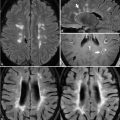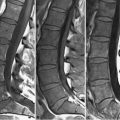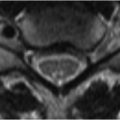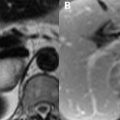37 Disk Herniations Motion from CSF pulsation, respiration, and the beating heart complicate imaging of the thoracic spine. These effects can be minimized by the use of gradient moment nulling and saturation pulses. Proper evaluation of the thoracic spine begins with the acquisition of localizer sequences. Numbering begins from the dens, proceeding downward. Proper identification of lesions in this manner is necessary as the number of vertebrae in a given person is variable, owing most frequently to the presence of a sacralized L5 or lumbarized S1. Figure 37.1A is a standard localizing scan consisting of composed images of the cervical, thoracic, and lumbar spine. If the entire spine is being imaged during a single given session then, as seen here, high-resolution images can be used for the localizer image. Alternatively, a faster localization scan can be obtained by overlaying lower quality images to form the composed sagittal image. In this particular T2W localizer scan, pathology of the cervical spine is identifiable in this Chiari 1 patient, including occipital decompression (note the missing posterior arch of C1) and a small cervical syrinx. In the thoracic spine, two areas of herniation are present. Figure 37.1B
![]()
Stay updated, free articles. Join our Telegram channel

Full access? Get Clinical Tree








